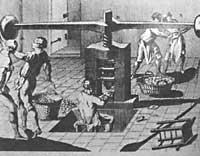Newton and his time
1992/02/01 Bandres Unanue, Luis Iturria: Elhuyar aldizkaria
Between the death of Galileo and the publication of Isaac Newton entitled Principia, there are only forty years. However, in this short period of time there was a great change in the scientific environment. On the one hand, the new philosophy of experimental science became a respectable tool in the hands of solid researchers, and on the other hand, this new attitude provoked many inventions, achievements and fruitful theories.
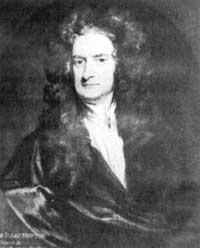
Works by Torricelli, Pascal, Guericke, Boyle and Mariott, especially on pneumatics and vacuum; on analytical geometry and optics by Descartes; astronomy and centripetal force by Huygens (he also invented his pendulum clock and wrote on light); laws on the talc of Huygenows, on the elasticity of John Christwopher, etc. Therefore, XVII. The 20th century was known as a century of geniuses.
The sciences were not isolated. Although it has not been possible to say that all scientists became followers of the new philosophy, year after year began from this line. Scientific societies were established in England, France and Italy. One of them is, as we have said before, the Royal Society created in London in 1662. The partners of these societies often had meetings, worked, discussed, written... The reading of scientific publications spread greatly. Science became a well differentiated activity and it developed very much.
Despite the social, political and economic changes at the basis of this great development, three more important factors were the existence of skilled men with great scientific knowledge, the delimitation and formulation of the problem and the acquisition of experimental and mathematical tools.
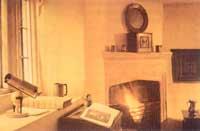
Skilled and curious men appeared anywhere. Some, like Newton, were of good education and worked in prestigious universities. Others, like Wren or Hook, had to take time out of their usual profession to devote themselves to scientific research. On the other hand, there was one or the other (Boyle for example) who could do what he wanted at home because he had enough money.
The road marked by Galileo to correctly formulate the problems was known. Thanks to their work, the observations and experiments of the world of actions gave their harvest. Most admitted observations and induction. Galileo was clear about the fruit they could bear by combining the daring hypotheses with mathematical deduction. Sterile introspection and contemptible attitude towards the image of dogmas had its repercussion in all areas of science.
Ancient questions of Plato (to express apparent movements of the planets, what hypothesis of uniform and orderly movement should be made? what he said) had no place in the new science. Instead, XVII. The greatest concerns among 20th century physicists were two others: What force affects the routes of the planets seen? and after the failure of Aristotle's theory of gravitation, how can we express the gravitation of the Earth?
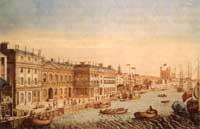
The tools, both mathematical and experimental, reached maturity. Much was used in the world of mathematical physics and these two areas brought beautiful harvests in mutual fertilizer. The same men (Descartes, Leibniz or Newton) made their discoveries in two fields. XVII. Analytical geometries established in the 19th century and calculations follow their current course. The telescope, microscope or vacuum pump opened two new and broad sections to science: the need to accurately measure the observed phenomena made new tools invented. As well as the establishment of a fruitful bridge that still lasts between scientists and tool manufacturers.
Newton came into the world in the midst of this environment. Christmas Day 1643 saw the light for the first time in the English village of Woolsthorpe. He was a quiet boy who liked to repair and manufacture mechanical appliances. He also had a special gift for mathematics.
He went to study at Trinity College in Cambrige, where he showed that he was a student and fast worker. At the age of twenty he had made important mathematical achievements: binomial theorem and differential calculus. He also worked on optics color theory and mechanics. On this period, Newton would later write:
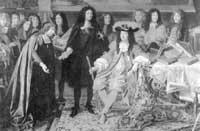
And that same year I began to think about the gravity that extended to the orbit of the Moon and... Based on Kepler's rule, I concluded that the forces that hold the planets in their orbits should be inversely proportional to the square of the distances to the center that they rotate. Therefore, I compared the force needed to keep the Moon in its orbit with the force of gravity on Earth and found a fairly accurate result for it. All this I did in the years 1665 and 1666 of the epidemic, since in those days I was at the best time for invention and reflected on mathematics and philosophy (physical science) (although then I did not do so well).
It seems that in those years he left Newton Cambridge University and worked on his own at his home in Woolsthorpe. He clearly developed the idea of the first two laws of motion, as well as the formula of centripetal acceleration, but about the latter Huygens he said nothing until a few years after the equivalent formulation.
At that time it seems that the story of the fall of the apple was based. In the biography that Newton's friend Stukely wrote about him, he says that on one occasion with Newton they were taking a cup in the garden under some tea apples, this told him: In a situation like this, for the first time I came up with the concept of gravitation, while I was sitting when an apple fell.
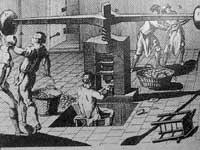
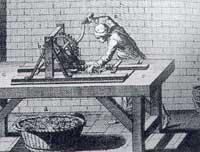
After returning to Cambridge, Newton gained great fame and after retiring the professor of mathematics there, he was given his post. He published his work in the Royal Society, especially in optics. However, when his Theory of Light and Colors was published in 1672, he had a painful and violent polemic with enemies and, on the other hand, his personality was so shy and humble that he did not publish anything else. Bertrand Russell said: If Newton had had the same difficulties as Galileo, we surely would not have known any line written by him. Newton then immersed himself above all in the work of his initial kneading mechanics.
He also studied the movement of planets as part of physics. In 1684, his friend Edmond Halley asked Newton for help in a discussion with Wren and Hooke. The subject of that debate was: The force that a body must bear to move in the elliptical orbit according to Kepler's laws. Newton told him that both this problem and many more had been solved with precision. Then Halley encouraged him to order and publish all the works that his friend had. Two years later and after a terrible job, his work Principia was in the hands of the editor. It was published in 1687 and this publication gave Newton fame to one of the greatest scientists in history.
A few years later, Newton had a depression because his health was always bad. After healing and until his death twenty-five years later, he made no major discovery and took care of his initial research (heat and optics). Every day he became more immersed in theology. In those years he had many honors: In 1699 he was appointed Keeper of the Mint (for his skill in metal chemistry). Subsequently, its chief responsible, collaborated in the reorganization of the English monetary traffic. In 1698 and 1701 he was representative of his university in Parliament. In 1705 he was knighted. From 1703 until his death, until 1727, he was president of the Royal Society. He is buried in the Westminster Abbey.
Beginner
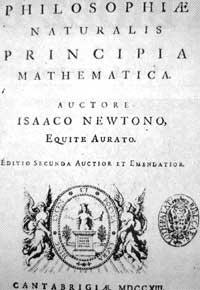
In the introduction of this book, perhaps the most prestigious in the history of physics, appears its brief outline:
Since ancient times (as Papus said), science called mechanics to investigate natural phenomena has been considered one of the most important, and as moderns, rejecting substantial form and hidden qualities, have tried to associate the phenomena of Nature to mathematical laws, but in this work I have used mathematics to the extent that they relate to philosophy (what we would today call physical science)... because the purpose of this work is to investigate phenomena... The general proposals of the books in the first and second aim. In the third book, I give an example of this, expressing the world system; through the proposals mathematically demonstrated in the first books, I conclude in the third (based on kneading phenomena) the gravitational forces of bodies with respect to the Sun and other planets. Therefore, through other mathematical proposals based on these forces he deduced the movements of the planets, comets, moon and seas.
The work begins with a definition of mass, amount of movement, inertia, force and centripetal force. Then he deals with absolute and relative space, time and movement.
Immediately and even in the introduction of his Principi, Newton establishes his three famous laws on motion and the basis of vector formation. In book I, entitled Movement of Bodies, he uses these laws in some of the problems of theoretical astronomy. Another use is the appearance of the puzolanic character of light: Newton analyzes the influence of surfaces on reflection and refractation on small fractions.
II. In the book, entitled Movement of bodies at resistive intervals, it seems that the goal is: Descartes' model of violence is not able to express the movements observed on the planets, but, in turn, represents a series of theorems and ideas about fluid properties. III. In his book, World Systems, he uses the results obtained in book I to express the movements of planets and other gravity phenomena such as tides. This book begins with the section Rules of Reasoning in Philosophy.
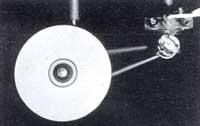
It gives us four rules that have been absolutely important in the development of science. In them we can appreciate Newton's firm faith in the uniformity of Nature and scientists help them develop hypotheses. The four rules are:
- rule: For natural things we must not admit any other cause, for everything is real and sufficient (both at once) to express their appearance.
From this philosophers do nothing in vain and one thing is even more useless to the extent that it has little use. Nature, then, is proud of simplicity and the bomb of excessive causes does nothing to it. - rule: Therefore, to the same natural effects we must accuse, as far as possible, of the same causes. For example, the breath
of a man and an animal; the fall of stones in America and Europe; the light of the flame of our kitchen and the Sun; the reflection of light on Earth and on planets are of the same cause. - rule: The qualities of bodies that do not allow to increase or decrease their intensity in the investigations of our experiments, whatever they may be, if they are present in all bodies, must be considered as a universal quality
of all bodies. All the qualities of bodies are known by experience..., in exchange for dreams we cannot ignore the notoriety of experiments...; It always agrees with the simple nature and the same. To know the extent of the bodies we have no choice but our sense and we do not reach all the bodies. But, as we see the extent of all we detect, ... - rule: Although the hypothesis can be thought of, we must consider that the proposals we derive from general inductions based on phenomena (until other phenomena occur that do not conform to them) are concrete or almost certain.
III. at the end of the book there is a section called General Scholium, very important in the scientific method. After concluding that it is possible to express the world system by recognizing that there is a universal gravitational force between all parts of the matter of the universe, Newton recognizes that he cannot say where the cause of that force lies, and without making any artificial hypothesis that is not clear, he affirmed that famous testimony of his honesty: Hypothese non fingo, i.e. I do not invent hypotheses.
XVIII. In the first half of the 20th century, the consequences of Newton Principi were also extrapolated to other sciences and philosophy. The mechanical vision of the world was broadened and according to him the intelligence of man was able to understand all phenomena by a mechanical expression. This opinion was especially developed by philosophers and had enormous consequences on economy, religion and political theory. Newton's success decisively influenced the ideas and methods of the Reason Age that would later come.

Gai honi buruzko eduki gehiago
Elhuyarrek garatutako teknologia




